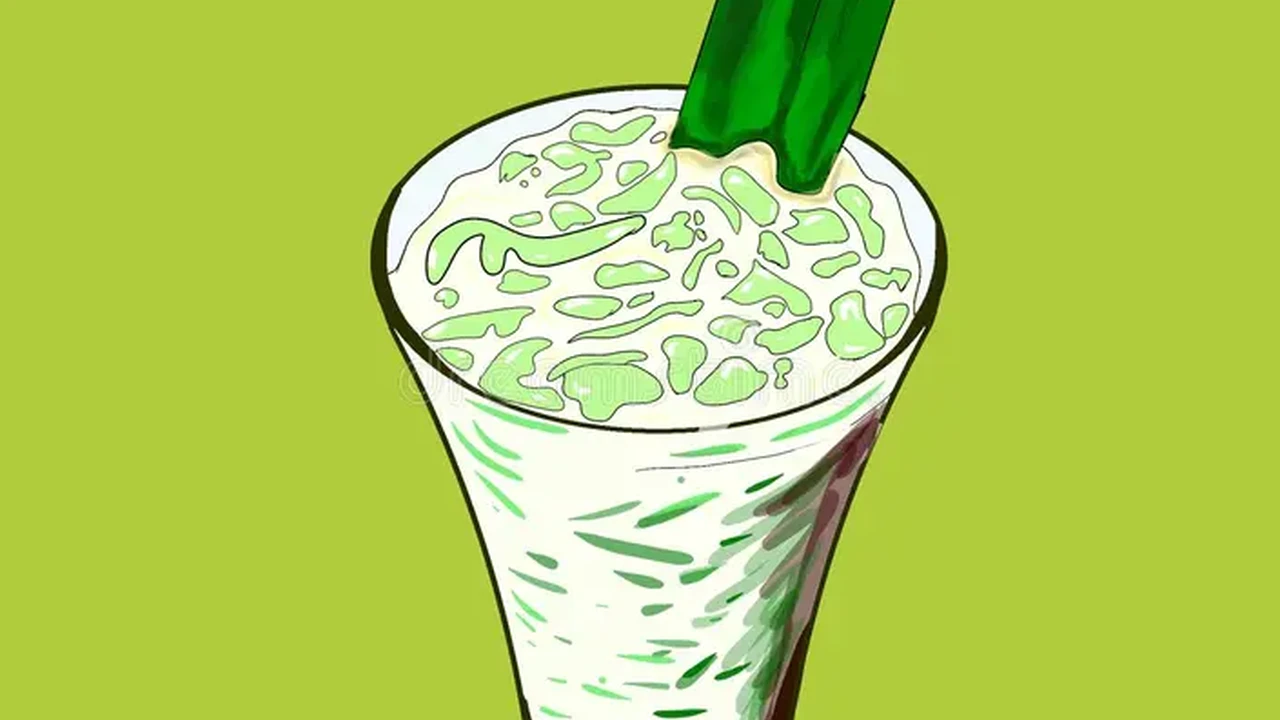Chendol: An Iced Dessert with Coconut Milk and Palm Sugar

What is Chendol A Malaysian Dessert Delight
Okay, let's talk Chendol. Seriously, if you're in Malaysia (or even thinking about it), you HAVE to try this. It's not just a dessert; it's an experience. Imagine this: a tall glass filled with shaved ice, swimming in creamy coconut milk, drizzled with rich, dark palm sugar (gula melaka), and then... those green jelly noodles. That’s Chendol in a nutshell. But trust me, it's so much more than the sum of its parts.
The Key Ingredients of Authentic Chendol and Their Origins
So, what makes Chendol, well, Chendol? Let's break down the stars of the show:
- Shaved Ice: The foundation! It needs to be finely shaved, almost like snow, to soak up all the delicious flavors.
- Coconut Milk: Freshly squeezed is the way to go! It provides the creamy, rich base that balances the sweetness. It should be thick and fragrant.
- Gula Melaka (Palm Sugar): This is the magic ingredient. It's a dark, caramel-like sugar made from the sap of palm trees. The best Gula Melaka has a smoky, complex flavor. The quality of the Gula Melaka makes or breaks the Chendol.
- Green Jelly Noodles: These are made from rice flour and flavored with pandan leaves, giving them that vibrant green color and a slightly grassy aroma. They add a chewy texture that's super satisfying. Some variations use mung bean starch.
- Red Beans: Often added for extra texture and a slightly earthy flavor. They provide a counterpoint to the sweetness.
While the basic recipe is fairly consistent, you'll find regional variations. Some places add glutinous rice, creamed corn, or even durian! It's all part of the adventure.
Chendol Variations Exploring Regional Differences in Malaysia
Malaysia is a melting pot of cultures, and that shows in its food! Chendol is no exception. Here's a quick tour of some regional spins:
- Penang Chendol: Often considered the "classic." Known for its generous portion of Gula Melaka and creamy coconut milk. The green jelly is often slightly firmer.
- Malacca Chendol: Malacca is famous for its Gula Melaka, so you can expect a particularly rich and flavorful version here. They sometimes add sago pearls.
- Kuala Lumpur Chendol: You'll find a wider range of variations in KL, from traditional to more modern takes with ice cream or chocolate sauce.
- Singapore Chendol: While technically not in Malaysia, Singapore's Chendol is very similar and worth mentioning. It often includes attap seeds (palm seeds).
Don't be afraid to try Chendol wherever you go in Malaysia! Each place has its own unique twist.
Where to Find the Best Chendol Local Recommendations and Hidden Gems
Alright, let's get to the good stuff: where to find the best Chendol! This is subjective, of course, but here are a few recommendations based on my own (extensive!) Chendol research:
- Penang Road Famous Teochew Chendul (Penang): This is a classic for a reason. Expect long lines, but it's worth the wait. Their Gula Melaka is top-notch.
- Jonker 88 (Malacca): Located on Jonker Street, this place serves a mean Baba Laksa and equally satisfying Chendol. Try the Durian Chendol if you're feeling adventurous!
- Devi's Corner (Kuala Lumpur): While known for its banana leaf rice, Devi's Corner also does a solid Chendol. It's a great place to cool down after a spicy meal.
- Gerai Makan Siput (Johor Bahru): This unassuming stall in Johor Bahru serves a delightful Chendol at an affordable price.
Don't be afraid to ask locals for their recommendations! They'll often point you to hidden gems you won't find in any guidebook.
Chendol Products Recommendations Exploring Different Brands and Options
Okay, let's talk about bringing the Chendol experience home! While nothing beats freshly made Chendol from a street vendor, there are some products you can use to create your own version.
- Gula Melaka: This is the most important ingredient! Look for blocks of dark, fragrant Gula Melaka. Brands like "Cap Nyonya" and "Malacca Boy" are generally reliable. You can find them in most Asian grocery stores. Price: RM 10-20 per kg.
- Pandan Extract: To make the green jelly noodles, you'll need pandan extract. Look for natural pandan extract, not artificial flavoring. Brands like "Koepoe Koepoe" are widely available. Price: RM 5-10 per bottle.
- Coconut Milk Powder: While fresh coconut milk is best, coconut milk powder is a convenient alternative. Brands like "Kara" and "Santan" are good options. Price: RM 8-15 per packet.
- Ready-Made Green Jelly Noodles: If you don't want to make the jelly noodles from scratch, you can find them pre-made in some Asian grocery stores. Look for brands that use natural pandan coloring. Price: RM 5-10 per packet.
How to Make Chendol A Step-by-Step Guide for Home Preparation
Want to try making Chendol at home? Here's a simplified recipe:
- Prepare the Gula Melaka Syrup: Simmer Gula Melaka with a little water until it dissolves and thickens. Strain to remove any impurities. Let it cool.
- Make the Green Jelly Noodles (or use store-bought): If making from scratch, mix rice flour and pandan extract with water. Cook over low heat until it thickens. Press through a colander into a bowl of ice water to form the noodles.
- Assemble the Chendol: In a tall glass, layer shaved ice, green jelly noodles, red beans (if using), and coconut milk. Drizzle generously with Gula Melaka syrup.
- Enjoy!
Experiment with different ingredients and ratios to find your perfect Chendol recipe!
Chendol Serving Suggestions Creative Ways to Enjoy This Dessert
Chendol is delicious on its own, but here are a few ways to spice things up:
- Durian Chendol: Add a scoop of durian flesh for an extra pungent and creamy treat.
- Chocolate Chendol: Drizzle with chocolate sauce or add chocolate shavings for a decadent twist.
- Coffee Chendol: Add a shot of espresso for a caffeinated kick.
- Chendol Milkshake: Blend all the ingredients together for a refreshing milkshake.
Get creative and experiment with different flavors and toppings!
Chendol Compared to Other Southeast Asian Desserts Similarities and Differences
Chendol is part of a family of similar Southeast Asian desserts. Here's how it compares to a few others:
- Es Cendol (Indonesia): Very similar to Malaysian Chendol, but often uses a slightly different type of green jelly.
- Lod Chong (Thailand): Similar ingredients but the green jelly noodles are often shorter and thicker.
- Banh Lot (Vietnam): Uses similar green jelly noodles but often served with mung bean paste and coconut cream.
While the ingredients are similar, each dessert has its own unique flavor profile and texture.
The Cultural Significance of Chendol A Dessert with a Rich History
Chendol is more than just a dessert; it's a part of Malaysian culture. It's often enjoyed during hot weather, celebrations, and family gatherings. It's a symbol of Malaysian hospitality and a reminder of simpler times.
The origins of Chendol are debated, but it's believed to have originated in Java, Indonesia, and spread throughout Southeast Asia. It's a testament to the region's shared culinary heritage.
Chendol and Health Considerations Nutritional Information and Potential Allergies
Let's be honest, Chendol is a treat, not a health food! It's high in sugar and calories. However, it does contain some nutrients from the coconut milk and red beans.
Here's a general nutritional breakdown (per serving):
- Calories: 300-400
- Sugar: 30-40 grams
- Fat: 15-20 grams
Potential allergens include coconut, red beans, and rice flour. Be sure to check the ingredients if you have any allergies.
Enjoy Chendol in moderation as part of a balanced diet.
Chendol Modern Interpretations and Fusion Creations
Chendol is a classic, but that doesn't mean it can't be modernized! Here are a few examples of modern interpretations:
- Chendol Ice Cream: Many ice cream shops now offer Chendol-flavored ice cream.
- Chendol Cake: Some bakeries have created Chendol-inspired cakes with layers of coconut cream, Gula Melaka, and green jelly.
- Chendol Cocktails: Bars are experimenting with Chendol-inspired cocktails using coconut milk, Gula Melaka, and pandan extract.
These modern takes on Chendol show that this classic dessert can be adapted to suit contemporary tastes.
Chendol Recipe Variations Exploring Different Ingredients and Techniques
Want to tweak the classic Chendol recipe? Here are a few ideas:
- Vegan Chendol: Use coconut cream instead of coconut milk and agar-agar for the green jelly noodles.
- Low-Sugar Chendol: Use a sugar substitute like stevia or erythritol for the Gula Melaka syrup.
- Spicy Chendol: Add a pinch of chili flakes to the Gula Melaka syrup for a spicy kick.
Don't be afraid to experiment and create your own unique Chendol recipe!
Chendol and Sustainability Sourcing Ingredients Responsibly
It's important to consider the sustainability of the ingredients used in Chendol. Look for Gula Melaka that is sourced from sustainable palm plantations and coconut milk that is produced ethically.
Support local farmers and producers who are committed to sustainable practices.
Chendol DIY Kits Bringing the Chendol Experience Home
Several companies now offer Chendol DIY kits, which include all the ingredients you need to make Chendol at home. These kits are a convenient way to enjoy Chendol without having to source all the ingredients yourself.
Look for kits that use high-quality ingredients and come with clear instructions.
Chendol and Travel Tips How to Find Authentic Chendol While Traveling in Malaysia
Here are a few tips for finding authentic Chendol while traveling in Malaysia:
- Ask locals for recommendations.
- Look for stalls that are popular with locals.
- Try Chendol from different regions.
- Be adventurous and try different variations.
Most importantly, enjoy the experience!
Chendol Storage Tips Preserving Freshness and Flavor
Chendol is best enjoyed fresh, but if you have leftovers, here are a few storage tips:
- Store the ingredients separately.
- Keep the shaved ice in the freezer.
- Store the coconut milk and Gula Melaka syrup in the refrigerator.
- Consume within 24 hours.
The green jelly noodles may become slightly harder after being refrigerated.
Chendol and Social Media Sharing Your Chendol Adventures
Don't forget to share your Chendol adventures on social media! Use hashtags like #Chendol #MalaysianDessert #GulaMelaka #Foodie to connect with other Chendol lovers.
Share your photos, recipes, and recommendations!
Chendol and the Future Trends and Innovations
Chendol is a timeless classic, but it's also constantly evolving. Expect to see more modern interpretations, fusion creations, and sustainable practices in the future.
The future of Chendol is bright!
:max_bytes(150000):strip_icc()/277019-baked-pork-chops-with-cream-of-mushroom-soup-DDMFS-beauty-4x3-BG-7505-5762b731cf30447d9cbbbbbf387beafa.jpg)






